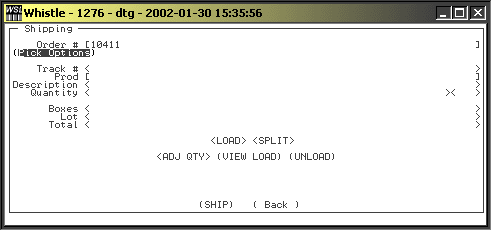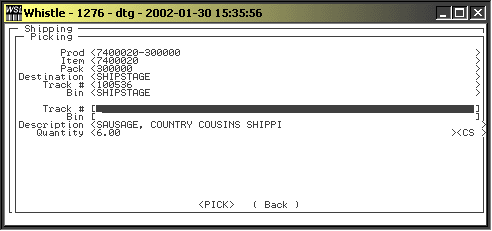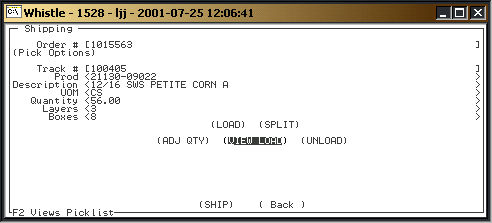Difference between revisions of "GS:Ship Window"
| Line 19: | Line 19: | ||
Whistle will return to the main shipping screen with the correct order number. | Whistle will return to the main shipping screen with the correct order number. | ||
| + | |||
| + | ;Note: Remember, if you just enter in an order number, Whistle will automatically assume you are shipping a Sales Order. If you want to ship a Warehouse Transfer, you must press "Ctrl-A", and select it in the menu. | ||
| + | |||
==Picklist== | ==Picklist== | ||
Revision as of 18:21, 23 June 2006
The Shipping function allows the user to pick and fill sales orders that need to be shipped. Shipping and picking personnel will most often use this screen.
Contents
Shipping
Select ‘Shipping’ from the main menu to access the Shipping menu. This screen will also have a window-tab feature like Report Production and is accessed in the same way.
If you are shipping a Sales Order and you know the order number, just enter it. If you are shipping a Warehouse Transfer, or you are shipping a Sales Order but don't know the number, press the "Ctrl-A" keys. You will see a small options menu.
Select whether you are shipping a Sales Order or a Warehouse Transfer, by highlighting your selection, and pressing "Enter". Whistle will immediately look for all of the open SOs or WTs that need to be filled.
Use the arrow and/or tab keys to highlight the order that you want to fill. Press "Enter".
Whistle will return to the main shipping screen with the correct order number.
- Note
- Remember, if you just enter in an order number, Whistle will automatically assume you are shipping a Sales Order. If you want to ship a Warehouse Transfer, you must press "Ctrl-A", and select it in the menu.
Picklist
- NOTE
- Whistle must generate a PICKLIST for all Shipping Orders that you want to fill. A PICKLIST is a list of specific containers that are allocated to filling the particular sales order. Once you generate a PICKLIST, all conainers on the PICKLIST will be reserved for use by that sales order alone. The containers will not be able to be used for anything else.
If a PICKLIST has not been generated for this order, Whistle will ask you if you would like to generate one at this time. Select <YES> to generate a PICKLIST. Be patient, for this may take a little time.
The cursor will automatically move to the ‘<Pick Options>’ option.
Press ‘Enter’ to view a list of Pick Options.
You have 4 options...
Next Pallet
[Image:Shipping15.gif]]
Whistle is set up to automatically tell you which container to pick next. Whistle will automatically take you to the Picking screen.
Choose From List
This option allows you to choose a particular container from the PICKLIST. The following PICKLIST screen will be displayed...
Select the desired Container to load it into the Picking Screen.
Regenerate
This option will regenerate another PICKLIST.
Deallocate List
Use this option to release from hold all of the containers that are on the PICKLIST. This will destroy the PICKLIST. You will have to create another PICKLIST if you want to pick items for this sales order.
Press ‘Enter’ to load the item into the main shipping screen.
Whistle will default to ‘Picking’ function. This function will suggest a Tracking # and Bin location from which to pick the appropriate container.
Scan the Tracking # and Bin # of the container selected.
Select <PICK>> to enter the container into the Shipping frame for loading.
Select <YES> to build the container and proceed to the Shipping screen.
The selected container must next be loaded for shipping.
Over Quantity Pallet
- NOTE
- You may receive the following message if the container you choose exceeds the quantity required to complete the order.
Select <OK> to clear the message and proceed to the main shipping screen. If you want to ship the exact quantity required, choose <SPLIT> from the main menu to split the pallet in two and only ship the amount required. Proceed to the SPLIT PALLET section for details on how to split a pallet.
You have several options at this point:
LOAD
Select <LOAD> to load the container as it is. If the container’s quantity exceeds the quantity required for the load, you will be asked again if you would like to split the pallet.
Select <YES> if you would like to split the container and proceed to the SPLIT PALLET screen.
SPLIT
Select <SPLIT> to split a pallet in two. Proceed to the section, “Split Pallet”, for details on how to use the SPLIT PALLET Screen.
Adjust Quantity
Select <ADJ QTY> to adjust the quantity located on the container. Only use this function if the quantity on the container differs from the quantity Whistle *thinks* is on the container. Whistle will take you to the ADJUST QUANTITY Screen. Proceed to the “Adjust Quantity” Section for details on how to use this screen.
VIEW LOAD
Select <VIEW LOAD> to view what has already been loaded for this order. Proceed to the “View Load” section of this chapter for details on using this function.
UNLOAD
Select <UNLOAD> to unload a particular container that has already been loaded. Proceed to the “Unload” section of this document for details on how to use this function.
LOAD
Select <LOAD> to load the container. For all other options, proceed to the following sections. The following message will be displayed if the container was successfully loaded:
Select <OK> to continue.
Whistle will default back to ‘Picking’ mode after a container is loaded into the system. It will automatically select the next container to pick. Repeat this Picking / Loading process until all items on the shipping order are loaded. Once all items associated with a Sales Order are loaded, a Supervisor will review and ship them. The shipping process may be repeated until all of the day’s Sales Orders are filled.
To Split a Container
Select <SPLIT> from the main shipping screen. You will be taken to the “Split Pallet” screen.
Enter the destination Tracking # if you are moving the items to an existing container with an existing Tracking #. If you are moving the items to a new container, simply scroll through this field and Whistle will generate a new Tracking # for you.
Whistle will display the amount of the Item that already exists on the new container.
Enter the new container’s BIN #.
Enter the Quantity of the Item that you are going to move. If the quantity can be entered in several UOMs, use the ‘A’ and ‘Z’ keys to toggle between possible UOMs.
Use the space bar to select if you would like to PRINT a new label for the new container. Select <OK> to process the “Split Pallet” transaction.
Select <YES> to proceed with the transaction.
You will be given the opportunity to load the container in the Shipping Screen. Notice that the quantity that you will be loading has been decreased by the amount of item that you have transferred off of the container.
To Adjust the Quantity on the Container
Select <ADJ QTY> from the main Shipping Screen. You will be taken to the “Adjust Quantity” screen.
Select the Unit of Measure (UOM) of the Item for which you would like to Adjust the Quantity. Use the A and Z keys to change the UOM. Note that if there is only one UOM available, then you will not be able to select others.
Enter the container’s New Quantity. This is the quantity of the Item that is actually on the container.
- NOTE!!
- If you are using ‘CS’ as your UOM, then you may use the Layers and Boxes fields to calculate the number of cases on the container. This will eliminate the hassle of having to count every single case on the container.
Enter the Reason for why you are adjusting the quantity of this container. You may view a list of reasons by pressing Ctrl-A. Choose a reason from the displayed list. You may enter any Comment at the bottom of the screen to provide extra information about the details of this adjustment.
Select whether you would like to print a new label for the adjusted inventory. Use the space bar to toggle the Print setting from ‘X’ to ‘ ‘.
Select <OK> to proceed with the transaction.
Select <YES> to confirm that you would like to proceed with the transaction.
You will be brought back to the main Shipping Screen to have the opportunity to load the container for shipping.
To View what you have Loaded
Select <VIEW LOAD> to see a list of all items associated with the sales order.
Whistle will display a list of all items associated with the sales order that have been loaded.
Press any key to return back to the Shipping Screen.
To Unload Previously Loaded Items
Select <UNLOAD> to remove loaded containers from the system.
Enter the Track # or the Item # of the container that you wish to unload.
Select <UNLOAD> to process the unload transaction and return to the shipping screen.

















